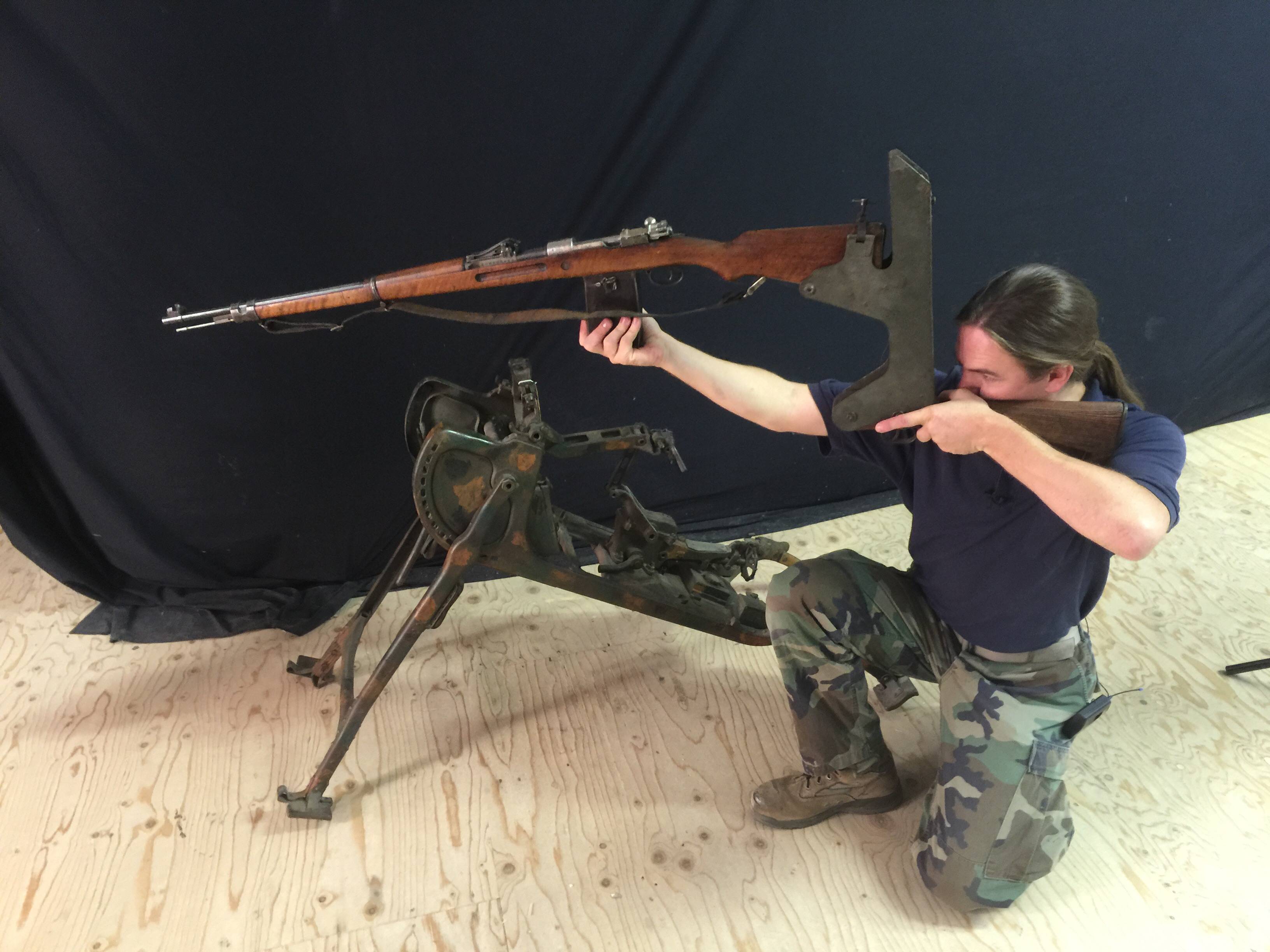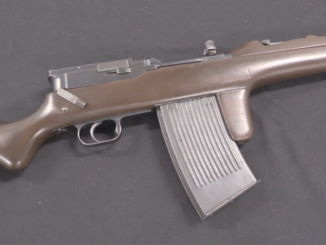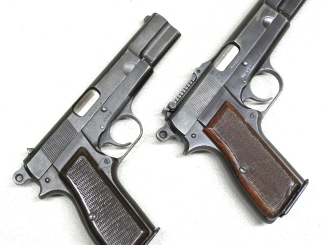Mauser’s classic early pocket pistol began as the model 1910, in .25 ACP caliber (6.35mm). It was then re-engineered for the larger .32 ACP (7.65mm) cartridge in 1914, and a final set of modifications too place in 1934. It is a simple blowback mechanism, with disassembly rather different from most other blowback pocket pistols.
Related Articles

Bolt Action Rifles
WWI Trench Mauser at James D Julia
As World War One stagnated into trench warfare, snipers and machine guns quickly proliferated, and exposure above the parapet of one’s trench could be extremely hazardous. This leaves one with the question of, how to […]

Semiauto Rifles
Mauser WW1 Flyer’s Rifle: the Flieger Selbstlader Karabiner 1916
Paul Mauser dedicated much of his life to the development of a practical semiauto military rifle, and did manage to have a design that was used in combat by Germany in World War One. It […]

Semiauto pistol
German Occupation FN High Power Pistols
When Germany occupied Belgium in the summer of 1940, the took over the FN factory complex and ordered production of the High Power pistol to continue. It was put into German service as the Pistole […]

I remember that the one I used to own that was carried as a “hideout” gun back in the day had a very rapid cycle due to that short slide stroke.
It could also be fired with either hand due to throwing the empties straight out to the right, which isn’t always advisable with pocket autos. (The later HsC model will boink you on the nose with the empty if fired left-handed.)
I also remember that the recoil didn’t seem as strong as the Beretta M1932 in .32 in spite of the similarly-shaped grip backstrap. However, counter-recoil tended to pull the muzzle down and forward as seen here.
I’ve never shot the two side-by-side, but I suspect you could obtain accurate rapid-fire multiple hits on the target faster with the Mauser than with the Beretta. Just a guess.
cheers
eon
Very well made handgun but, sometimes a stange malfunction occurs with some type of ammo and with aid of ejector which is a rocker piece functioning as a slide stop when the magazine is taken out. When a loaded magazine inserted into the pistol with the
slide on battery position, the ejector pushes the upper cartridge in the magazine slightly forward and if its sharp front tip finds home at primer seat recess of the cartridge case, it snaps into this very little step and blocks the vertical movement of magazine. If the user wants to take out the magazine, it will not even move. Slightly retracting the slide and lightly tapping under the magazine frees the ejector as causing to rock it backwards by force of its spring and the magazine can be taken out. To prevent this strange malfunction, the sharp tip of ejector should be slightly rounded with a diamond file.
В.Е. Маркевич in Ручное огнестрельное оружие described both (.25 Auto & .32 Auto) Mauser automatic pistol in one chapter titled Automatic Pistol System Mauser Model 1911:
-easy to disassembly and assembly, but parts of firing mechanism can be easily lost
-firing mechanism prone to dirt, in cold temperature misfires are frequent
-weak firing spring
6.35mm Browning (.25 Auto) version is long and heavy for cartridge size
Field stripping of Mauser 1910/1914 puts nearly same amount of loosable parts with other pistols of that era. But, detailed stripping is too easy and should not be attempted to make in field or battle conditions.
“began as the model 1910, in .25 ACP caliber (6.35mm)”
http://world.guns.ru/handguns/hg/de/mauser-1910-14-34-e.html
States that his fire-arm starts as a 9mm Luger (with smaller powder charge) which was adopted by Brazilian Navy, but it was not big success.
Yes, it did (they also made a few experimental ones in .45ACP). The larger caliber ones had a sort of delaying mechanism, but it never really worked well enough.
Neat vid… I’m guessing there’s a recoil spring at Wolff with this pistols name on it.
Thanks for the always interesting info on your site.
John
The Mauser 1914’s very short slide stroke is dictated by the spring loaded striker which is (unlike modern Gloc-type firearms) compressed against the frame when the slide moves backwards. This has the advantage of no springs working agains each other (in the Glock, striker spring and mainspring do this), but allows for a short slide stroke only, unless the slide and frame would be extended further rearwards.
Most of striker firers of that era, FN1906, FN1910/22, Ortgies, MAB… Share same “Frame supported main spring” features with Mauser 1910/14 pistols. They have longer back extentions as you stated, but this construction rises a tendency not to cock the striker as manually retracting the slide to load the chamber, which may be fatal in stressed conditions. Mauser short stroke might be provided to overcome this shortcoming. Striker firers cocking against to the recoil spring like new generation Glock, SW, Kahr, and old Franz Stock, Dreyse 1907 have another flaw of remaining out of battery if slide return spring gets weakened.
Ian, have you got access to an FN 1910 (or 10/22)? Might be interesting to see if you can capture the firing pin working as an ejector, which is an neat feature of these pistols.
I have the pistol but not the funky slowmo camera… Although if you wanted to make a trip to Switzerland one of these days!
As Ian notes, the recoil is rather vigorous. At the same time, the slide is rebated….reducing the mass. Just wondering, was this for commonality with various calibers and being able to handle the weakest of them?
Though Mauser 1910/1914 has a separate ejector, real empty case throwing happens through the push of striker just as being in FN 1910/22. The whirling brass seen in the slow motion video clearly indicates this. The spring forced firing pin tip is at behind of empty case and pushes it violently as soon as the case mouth clears off the chamber. But, ejecting the unfired live rounds are made by the hit of real ejector since the brass back strikes it earlier before to reach to the firing pin tip waiting on cocked mode at some more distance behind. The distance that empty case thrown away of the pistol indicates the state of efectiveness of locking mechanism to use correct gas power expelling the bullet out of the firearm. Longer throw indicates unsufficient gas capture and shorter throw indicates sufficient locking, or mass locking capturing the gas power inside the barrel to provide the needed push behind the bullet for handling optimum velocity and energy. lan’s video shows this requirement occuring in due course in Mauser 1914.
My dad got a model 1934 in 1945 off the radio operater of the U-190. when i was about 12 I decided that when one night my parents were away that I would take it out as dad had never let me handle it without him there
It was unloaded of course and i got the slide locked back.It took me 2 days to figure out that I had to take out the clip and put it back in to get the slide to go forward. Two days in which I was sure my dad wouyld find out I had broken his gun. I was 30 befor I told him about it and we had a good laugh
Very good pistol in my opinion (in its role of pocket pistol of course).
I got mine a year ago and was impressed by its accuracy, considering the size of the barrel and its age (90 years old), I do get a problem from time to time, the bullet gets stuck in the barell, and the empty case ejects, which is quite a big one since if a new bullrt if fed in it will fire in a clogged barrell …
Is this issue common with this model ?
I’ve tried it with several ammo types and the barrel is in pristine condition.
Please check the tip of striker being in correct shape and then its spring. They should be needed to change in old pistols and cause partial igniting resulting events you desciped.
Is there any modern commercially manufactured .32 ACP ammo that is safe to u se in a 1914 Mauser Pocket Pistol? I’ve seen powder loads of 4.60 gr or higher, and from what I’ve read, the original specs for the 1914 were 3.08 gr of powder.
Thanks for all you folks do At forgotten weapons.com. I have the 1910/1914 25 acp model. It shoots great but I have noticed the rear striker housing on the rear of the frame ( the piece that looks like a button) seems to be taking impact from the striker upon slide recoil. Ithe housing seems to be sticking slightly out beyond the slide now. What actually stops the rearward travel of the slide on these little pistols? Is it the striker to striker housing or something else worn on my model. Any advice greatly appreciated.